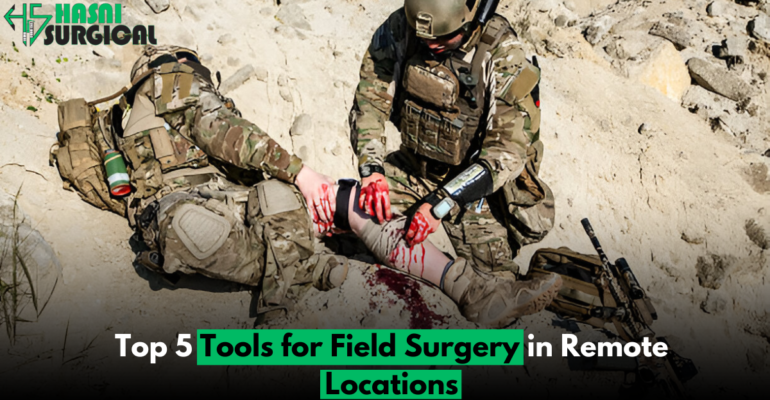Best 5 Tools for Field Surgery in Remote Locations
January 21, 2025 2025-01-21 10:50Best 5 Tools for Field Surgery in Remote Locations

Best 5 Tools for Field Surgery in Remote Locations
Field surgery in remote locations is perhaps the most challenging and critical area of healthcare. Whether it is disaster response, operating in conflict zones, or just delivering care in underserved rural areas, the right tools on hand can be the difference between life and death.
Compact, portable surgical kits are very important for such situations, as they provide life-saving solutions in resource-scarce and infrastructurally poor environments. Let us look at some of the top tools for field surgery and their importance in disaster relief and rural healthcare.

1. Field Surgical Kits: The Basis of Field Surgery
Field surgical kits are preassembled, self-contained kits for ease of transport and quick setup. Such kits contain most basic instruments, such as:
- Scalpels and blades
- Hemostats and clamps
- Trocars
- Scissors and forceps
- Sutures and needles
These kits are vital in handling wide surgical requirements, like debridement of wounds or smaller amputations where an operating room fully equipped cannot be accessed. They are portable in size and can be carried into disasters or remote, rural areas several hours from regular medical facilities.

2. Bone Saws and Orthopedic Instruments
Bone saws and orthopedic instruments are core in fracture management or amputation, particularly during disaster response work where crush injury is predominant. The design goals are now more towards light and durable material that has an ergonomic handle to reduce the hassle involved in handling it at the point of use.

3. ENT Instruments
ENT instruments, consisting of speculums, forceps, and suction tubes, are absolutely must-haves for clearing any obstructions from the airway or caring for facial trauma, which occurs in the trauma setting. The portable ENT kit allows practitioners to stabilize the patient quickly and easily.

4. Veterinary Instruments Cross-Purpose Usage
Many spay kits or cropping clamps that are designed by veterinarians end up being used for human applications in remote locations when emergencies occur. Their durable and multi-purpose nature makes them extremely useful for a field surgical setting, especially where human and veterinary healthcare needs are overlapping.

5. Micro and Neurosurgical Tools
Although surgical procedures like neurosurgery or microsurgery seldom occur in disaster settings, for example, very fine forceps, liposuction cannulas, and precision scissors, to name a few, can also be used on critical injuries concerning small vessels and nerves. It is usually integrated into advanced portable kits disaster teams have.
The Significance of Portable Surgical Kits in Disaster Relief and Rural Healthcare
1. Easy deployment with mobility
In general, disasters are usually experienced in areas where access to healthcare institutions is limited or destroyed. Portable surgical kits ensure that medical teams set up temporary operating stations in the disaster area and can provide necessary care at site.
2. Bridging Healthcare Gap
It might be hours or days for a surgeon in the countryside. The kits help the health provider to provide intervention and possibly cut down mortality rates and increase recovery.
3. Support of Humanitarian Actions
Compact surgical kits make it easy for medical personnel to reach more patients with fewer resources in refugee camps and conflict zones.
Conclusion
Field surgery in isolated areas is basically the marriage of skill, creativity, and utilization of appropriate gear. The confined surgical package, along with advanced instrumentation, become critical determinants in an ideal situation to offer proper medical treatment within a devastated area or some isolated village.
These tools cannot be overestimated to any greater heights. They are well-designed in a way that they tackle the problem of remote health care with respect to portability and durability in conjunction with ease of use outside a sterile condition. Thus, in places where healthcare facilities are restricted or nonexistent, they become of prime importance as a means of bringing in basic surgical intervention.
More dramatic innovations can be expected when the development of field surgery kits continues. With light materials, ergonomic design, and high-technology sterilization, such a kit would become even more efficient and accessible for the harsh environment. A good example of the future emerging technologies includes portable diagnostic equipment as well as modular surgical systems that would even increase the effectiveness of the medical team.
Such tools could be availed to the teams in order to help even the remote regions of the globe receive lifesaving surgeries, relieve pains, and receive high-quality health services. This not only cures acute medical needs but contributes to reducing the health gap by improving the overall global health equity. These field surgery tools, in concert with expertise and dedication, provide a beacon of hope for all those vulnerable populations
